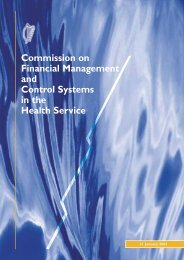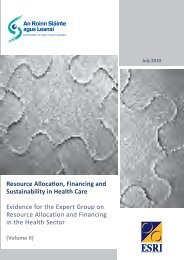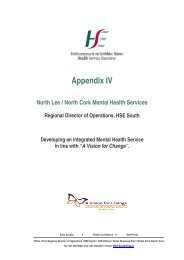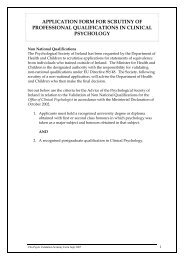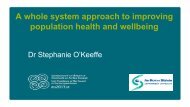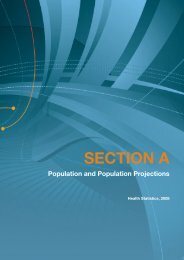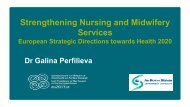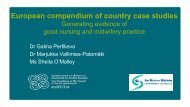Download this file
Download this file
Download this file
Create successful ePaper yourself
Turn your PDF publications into a flip-book with our unique Google optimized e-Paper software.
Haematopoietic stem cells:<br />
implications of the EU directive<br />
for practice in Ireland<br />
Paul Browne,<br />
Blood and Marrow Transplant Programme,<br />
St. James’s Hospital
The stem cell hierarchy<br />
Embryonic stem cell<br />
Pluripotent somatic<br />
stem cell<br />
Neural Muscle Hepatic Blood Endothelium
Stem cells live in<br />
bone marrow niches<br />
Stem cell<br />
Marrow<br />
stroma<br />
Adhesion<br />
molecule<br />
Matrix protein
G-CSF mobilises stem cells<br />
Circulation<br />
G-CSF<br />
BM stroma
What do stem cells look like
Red cell colony CFU-E
White cell colony CFU-GM
BMT: Stem cell source<br />
• Bone marrow from donor<br />
• Peripheral blood from donor<br />
• Umbilical cord blood<br />
• Autologous blood or marrow
Stem cell transplants<br />
in Europe<br />
HSCT rate in Europe 1990<br />
HSCT rate in Europe 2000
Transplant rate /10 X 10 6 inhabitants<br />
600<br />
500<br />
400<br />
Economic factors in HSCT:<br />
Transplant rate and GNP<br />
CZ<br />
300<br />
SK<br />
200<br />
EST HR<br />
100 PL<br />
BY TR<br />
0 BG<br />
RUS<br />
LTMK<br />
E<br />
P<br />
GR<br />
SLO<br />
IRL<br />
I<br />
FB<br />
S<br />
SF D<br />
UK<br />
where is Ireland<br />
NL A<br />
GNP = gross national product; HCE = health care expenditure per capita<br />
DK<br />
N<br />
CH<br />
0 10 20 30 40<br />
GNP per capita<br />
Social insurance based health care system<br />
Tax funded health care system<br />
Centralised health care system<br />
Transplant rate /10 X 10 6 inhabitants<br />
600<br />
500<br />
400<br />
300<br />
200<br />
100<br />
0<br />
PL<br />
TR<br />
RUS<br />
Transplant rate and HCE<br />
H<br />
CZ<br />
GR P<br />
SLO<br />
I<br />
E B F<br />
SF S D<br />
A NL<br />
UK<br />
DK<br />
IRL<br />
N<br />
CH<br />
0 1,000 2,000 3,000<br />
Healthcare expenditure per capita
HSCT in Europe 1990-2000<br />
Main indications: allogeneic<br />
5,000<br />
Number of HSCT<br />
4,000<br />
3,000<br />
2,000<br />
1,000<br />
0<br />
1990<br />
1991<br />
1992<br />
1993<br />
1994<br />
1995<br />
Year<br />
1996<br />
1997<br />
1998<br />
1999<br />
2000<br />
Leukaemia<br />
Lymphoma<br />
Non malignant<br />
disorders
HSCT in Europe 1990–2000<br />
Main indications: autologous<br />
6,000<br />
Number of HSCT<br />
5,000<br />
4,000<br />
3,000<br />
2,000<br />
1,000<br />
Leukaemia<br />
Lymphoma<br />
Myeloma<br />
Breast<br />
Cancer<br />
Other<br />
Solid<br />
Tumours<br />
0<br />
1990 1991 1992 1993 1994 1995 1996 1997 1998 1999 2000<br />
Year
Adult BMT Programme: St James’s Hospital<br />
Total Transplant Program 1984-2003<br />
120<br />
100<br />
80<br />
60<br />
40<br />
20<br />
1984<br />
1985<br />
1986<br />
1987<br />
1988<br />
1989<br />
1990<br />
1991<br />
1992<br />
1993<br />
1994<br />
1995<br />
1996<br />
1997<br />
1998<br />
1999<br />
2000<br />
2001<br />
2002<br />
2003<br />
0<br />
Year<br />
AUTO BMT<br />
ALLO BMT<br />
TOTAL<br />
No.of Transplants
BMT for haematological disorders<br />
• Acute myeloid leukaemia<br />
• Acute lymphoblastic leukaemia<br />
• Hodgkin’s disease<br />
• Non-Hodgkin’s lymphoma<br />
• Multiple myeloma<br />
• Chronic myeloid leukaemia<br />
• Aplastic anaemia
Survival of patients with acute myeloid<br />
leukemia after bone marrow transplant<br />
100<br />
PROBABILITY, %<br />
80<br />
60<br />
40<br />
20<br />
N = 59<br />
0<br />
0 1 2 3 4 5<br />
YEARS<br />
Fe03_5.ppt
Autografts by disease indication<br />
M yeloma<br />
34%<br />
ALL<br />
3%<br />
Germ Cell Ca<br />
5%<br />
Myelofibrosis<br />
1%<br />
CLL<br />
5%<br />
CML (STI)<br />
7%<br />
Lymphoma<br />
24%<br />
HD<br />
8%<br />
AML<br />
7%<br />
CML (new)<br />
6%<br />
Lymphoma n=21<br />
HD n=7<br />
AML n=6<br />
CML (new)n=5<br />
CML (STI) n= 6<br />
CLL n=4<br />
Germ Cell Ca n=4<br />
ALL n=3<br />
Myeloma n= 31<br />
Myelofibrosis n=1
Autologous stem cell harvests/cryopreservation:<br />
Shared care model<br />
Tullamore<br />
5%<br />
Cork<br />
7%<br />
Waterford<br />
9%<br />
Mater<br />
1% St James n=29<br />
St James<br />
32%<br />
Beaumont n=14<br />
Limerick n=12<br />
AMiNCH n=9<br />
Letterkenny /Sligo<br />
6%<br />
AMiNCH<br />
10%<br />
Limerick<br />
14%<br />
Beaumont<br />
16%<br />
Letterkenny /Sligo n=5<br />
Cork n=6<br />
Tullamore n=4<br />
Waterford n=8<br />
Mater n=1
The EU Directive<br />
• Competent authority:<br />
Irish Medicines Board<br />
• Tissue establishment:<br />
“The cryo/stem cell lab”<br />
• Responsible person:<br />
Medical Director
The Responsible Person<br />
The person designated under paragraph 1 shall be responsible for:<br />
(a) ensuring that human tissues and cells intended for human<br />
applications in the establishment for which that person is<br />
responsible are procured, tested, processed, stored and<br />
distributed in accordance with <strong>this</strong> Directive and with the laws<br />
in force in the Member State;<br />
(b) providing information to the competent authority or authorities<br />
as required in Article 6;<br />
(c) implementing the requirements of Articles 7, 10, 11, 15, 16 and<br />
18 to 24 within the tissue establishment.
The EU Directive:<br />
Quality Management System<br />
• Standard operating procedures<br />
• Training and reference manuals<br />
• Donor records<br />
• Traceability<br />
• Accurate documentation<br />
• Audit of outcome
Serious adverse events/reactions<br />
1. Member States shall ensure that there is a system in place to report,<br />
investigate, register and transmit information about serious adverse events<br />
and reactions which may influence the quality and safety of tissues and cells<br />
and which may be attributed to the procurement, testing, processing, storage<br />
and distribution of tissues and cells, as well as any serious adverse reaction<br />
observed during or after clinical application which may be linked to the<br />
quality and safety of tissues and cells.<br />
2. All persons or establishments using human tissues and cells regulated by <strong>this</strong><br />
Directive shall report any relevant information to establishments engaged in<br />
the donation, procurement, testing, processing, storage and distribution of<br />
human tissues and cells in order to facilitate traceability and ensure quality<br />
and safety control.<br />
3. The responsible person referred to in Article 17 shall ensure that the<br />
competent authority or authorities is or are notified of any serious adverse<br />
events and reactions referred to in paragraph 1 and is or are provided with a<br />
report analysing the cause and the ensuing outcome.
Import/export of stem cells<br />
Member States shall take all necessary measures to ensure that<br />
all imports of tissues and cells from third countries are<br />
undertaken by tissue establishments accredited, designated,<br />
authorised or licensed for the purpose of those activities, and<br />
that imported tissues and cells can be traced from<br />
the donor to the recipient and vice versa in accordance with the<br />
procedures referred to in Article 8.<br />
Member States and tissue establishments that receive such<br />
imports from third countries shall ensure that they meet<br />
standards of quality and safety equivalent to the ones laid down<br />
in <strong>this</strong> Directive.
Core principle:<br />
Progenitor cell products are unique<br />
and irreplaceable
SJH Cryobiology Lab activity<br />
Cryobiology Lab Total Procedures: 1998-2003.<br />
600<br />
500<br />
400<br />
300<br />
200<br />
100<br />
0<br />
1998 1999 2000 2001 2002 2003
Laboratory personnel<br />
Minimum staffing for any functional<br />
cryobiology laboratory includes:<br />
• Chief Medical Scientist, serving as<br />
Laboratory Director<br />
• Senior Medical Scientist (2 posts)<br />
• Basic Grade Medical Scientist (2 posts)<br />
• Quality Manager
Laboratory facility<br />
How clean is a clean room<br />
Controlled environment<br />
Gowning<br />
cGMP facility<br />
What level<br />
Microbiological control
JACIE standards and programme
HSC laboratories in Ireland<br />
•Cork<br />
•Galway<br />
• Dublin: St. James<br />
St. Vincents<br />
Mater<br />
OLHSC
Irish Haematology Society:<br />
Summary of recommendations<br />
• Develop JACIE/cGMP standard cryobiology laboratories at IBTS<br />
Dublin, Cork<br />
• Transfer of existing hospital-based processing at St. James’s to<br />
IBTS facility.<br />
• Enhancement of existing facilities at St. Vincent’s Hospital, Mater<br />
and Galway to cGMP standard<br />
• Discussions with Crumlin OLHSC re optimal development of<br />
paediatric stem cell laboratory<br />
• Each laboratory to provide support for products collected and/reinfused<br />
at one or multiple approved clinical transplant sites/units.<br />
• Provision of consultant sessional commitment for each designated<br />
facility, as outlined
Implementation in Ireland<br />
• DOHC Steering group<br />
• Health Service Executive<br />
• Resource implication



